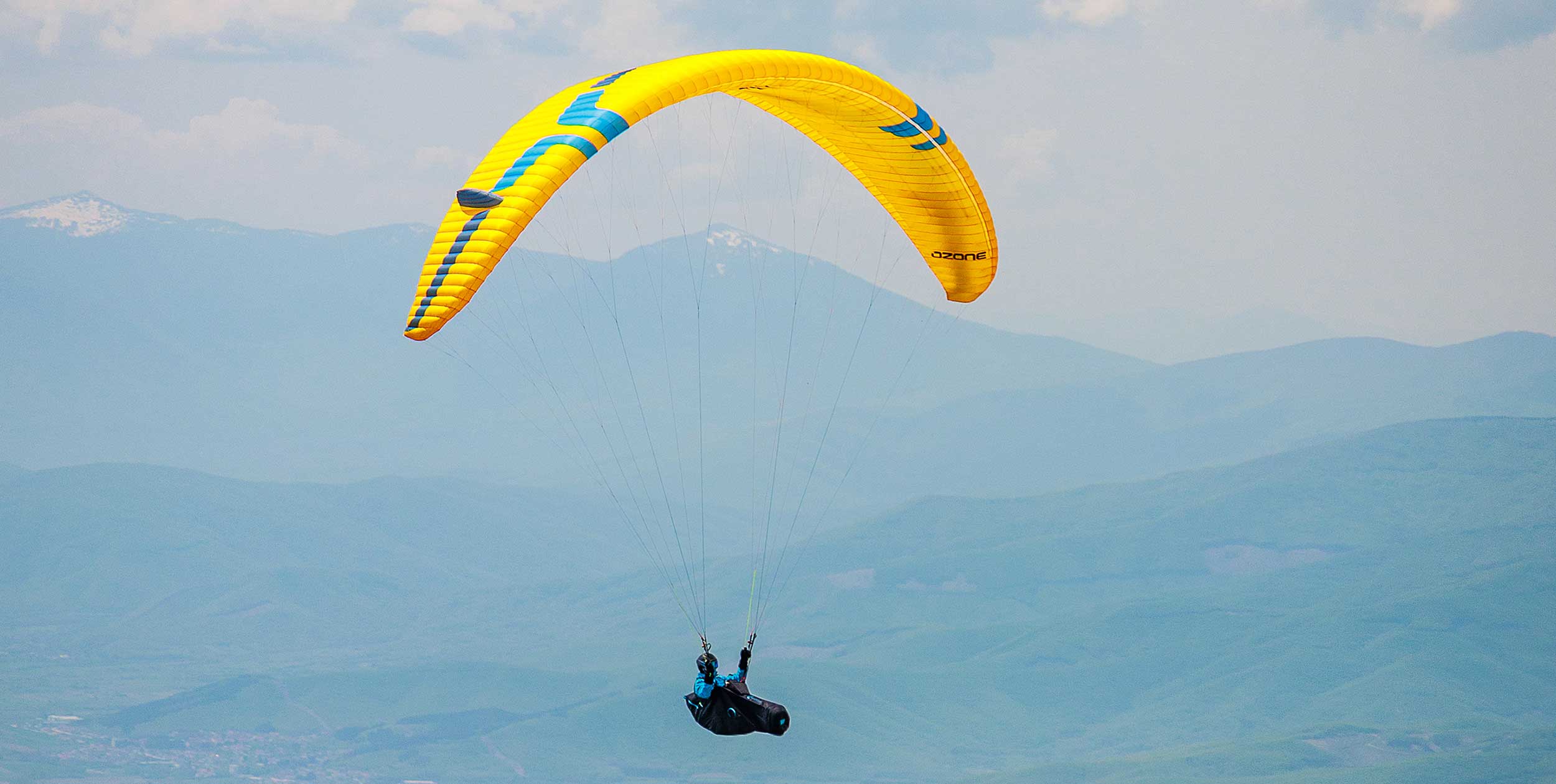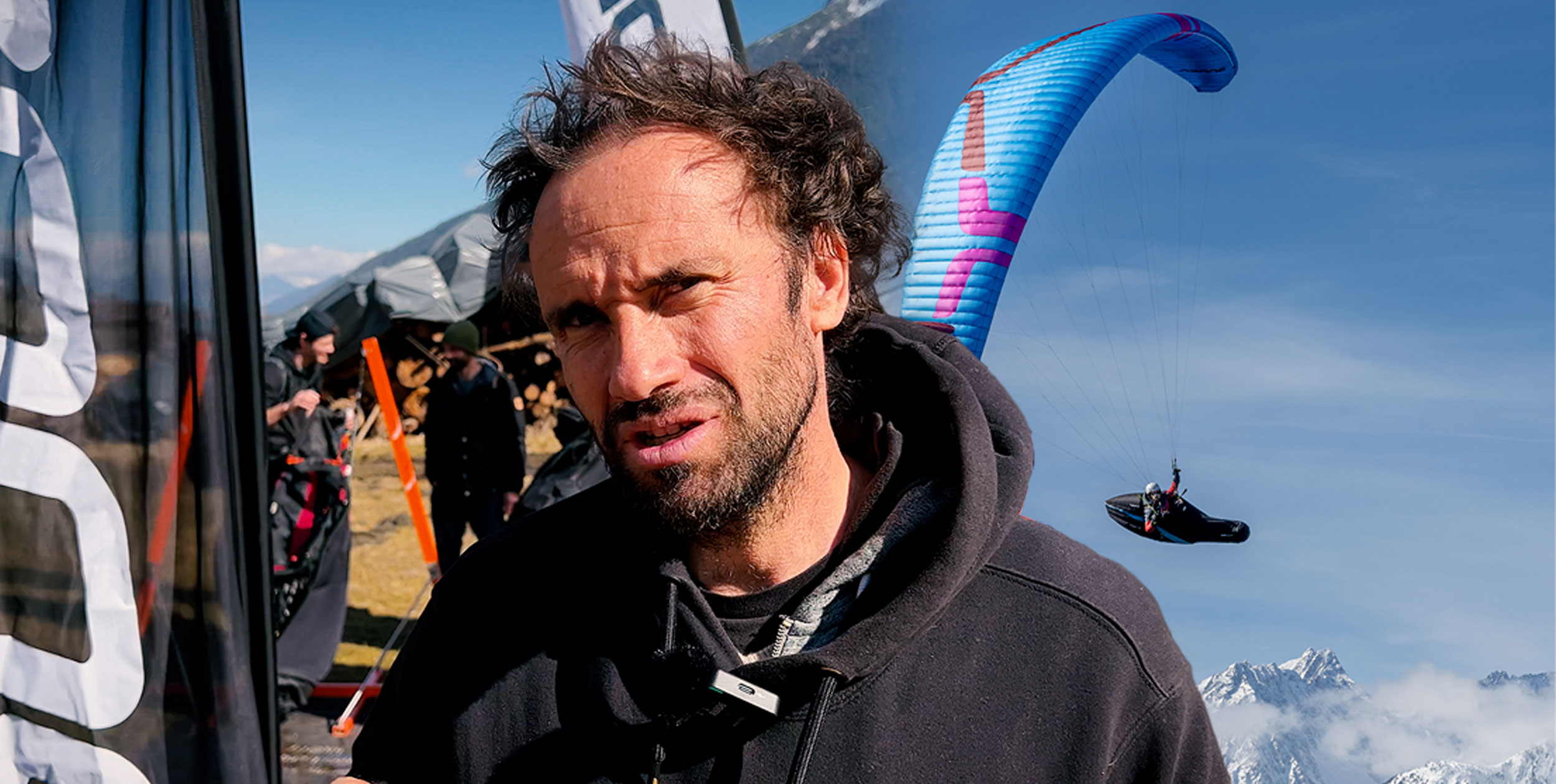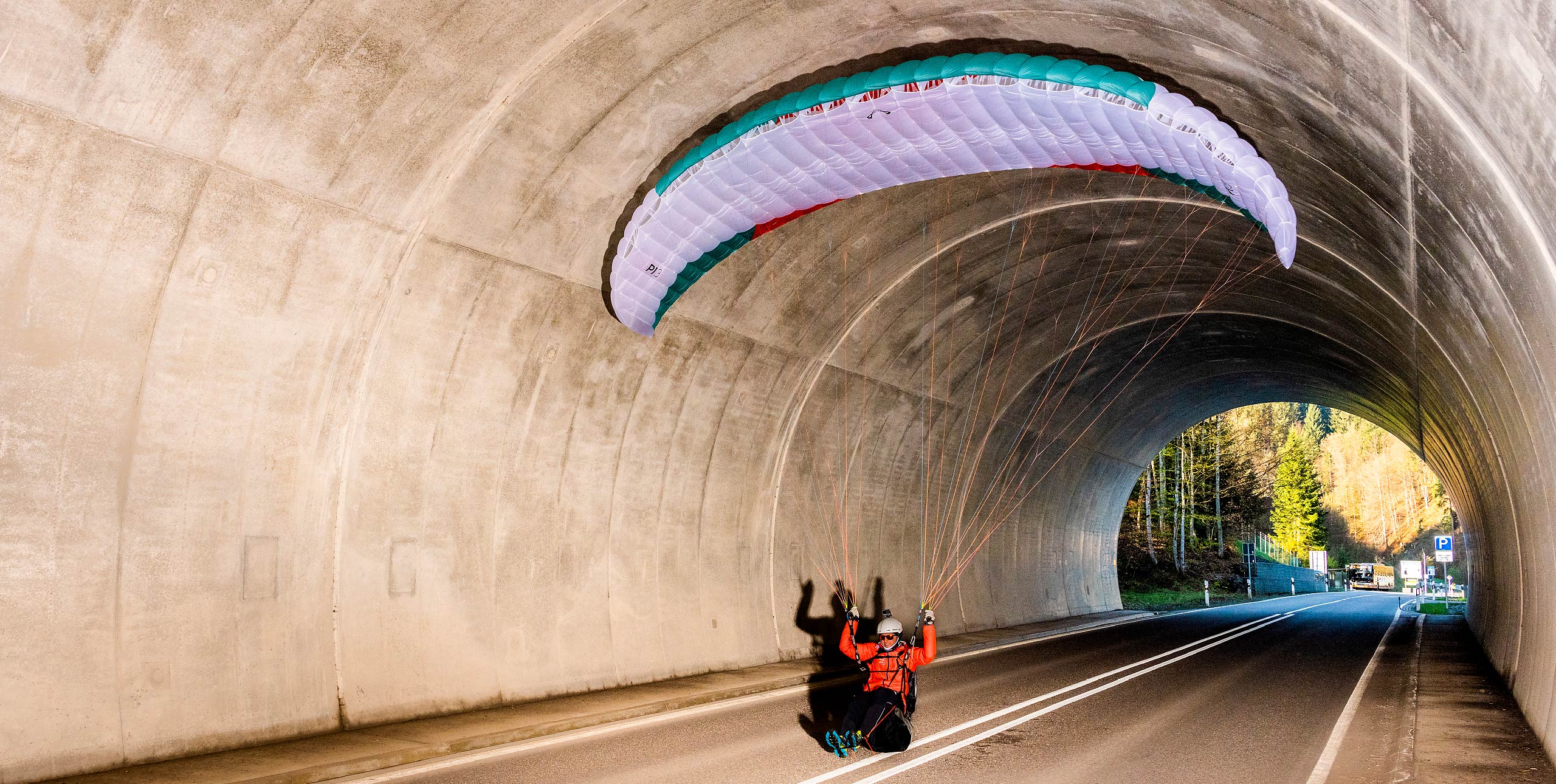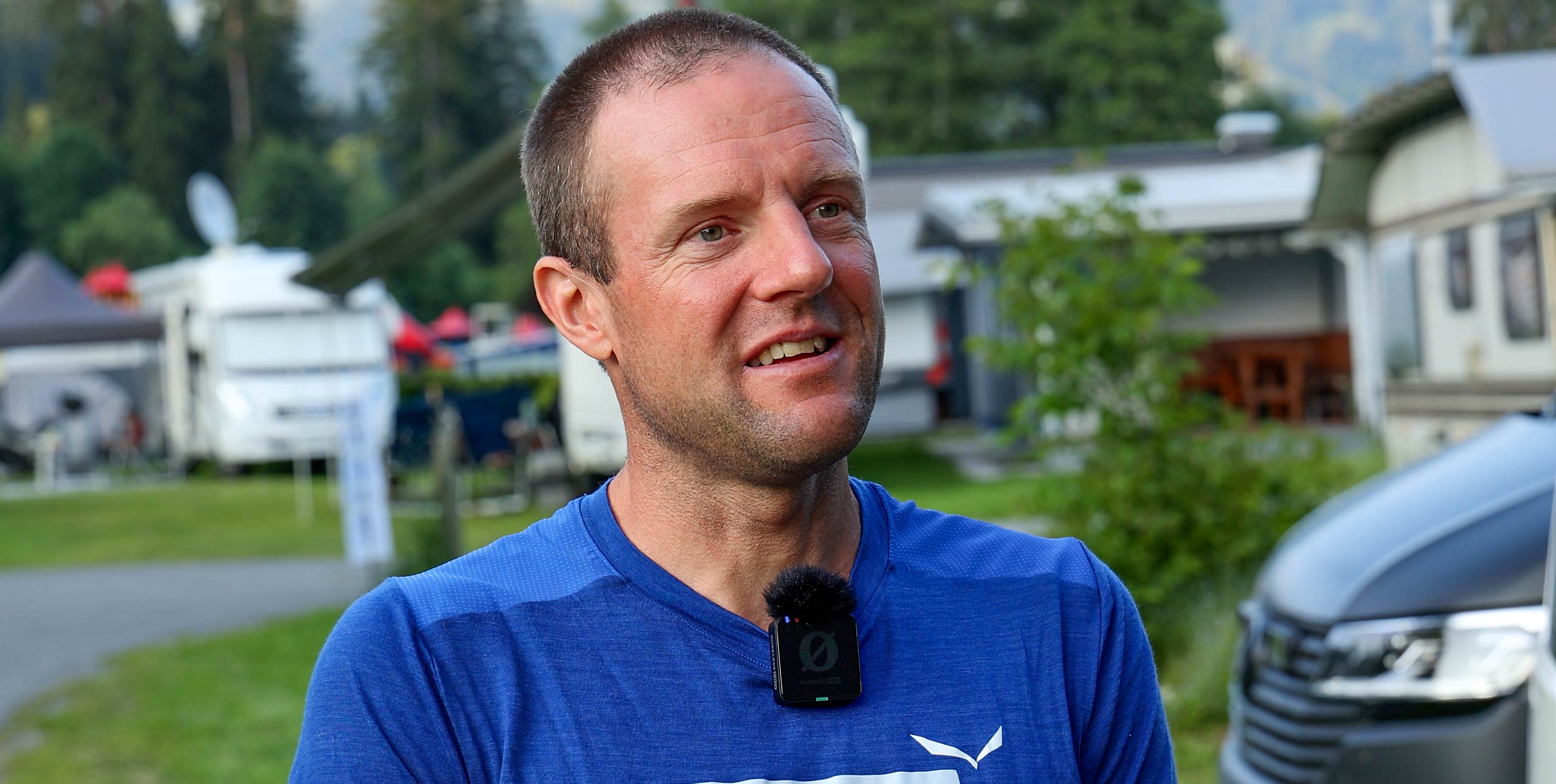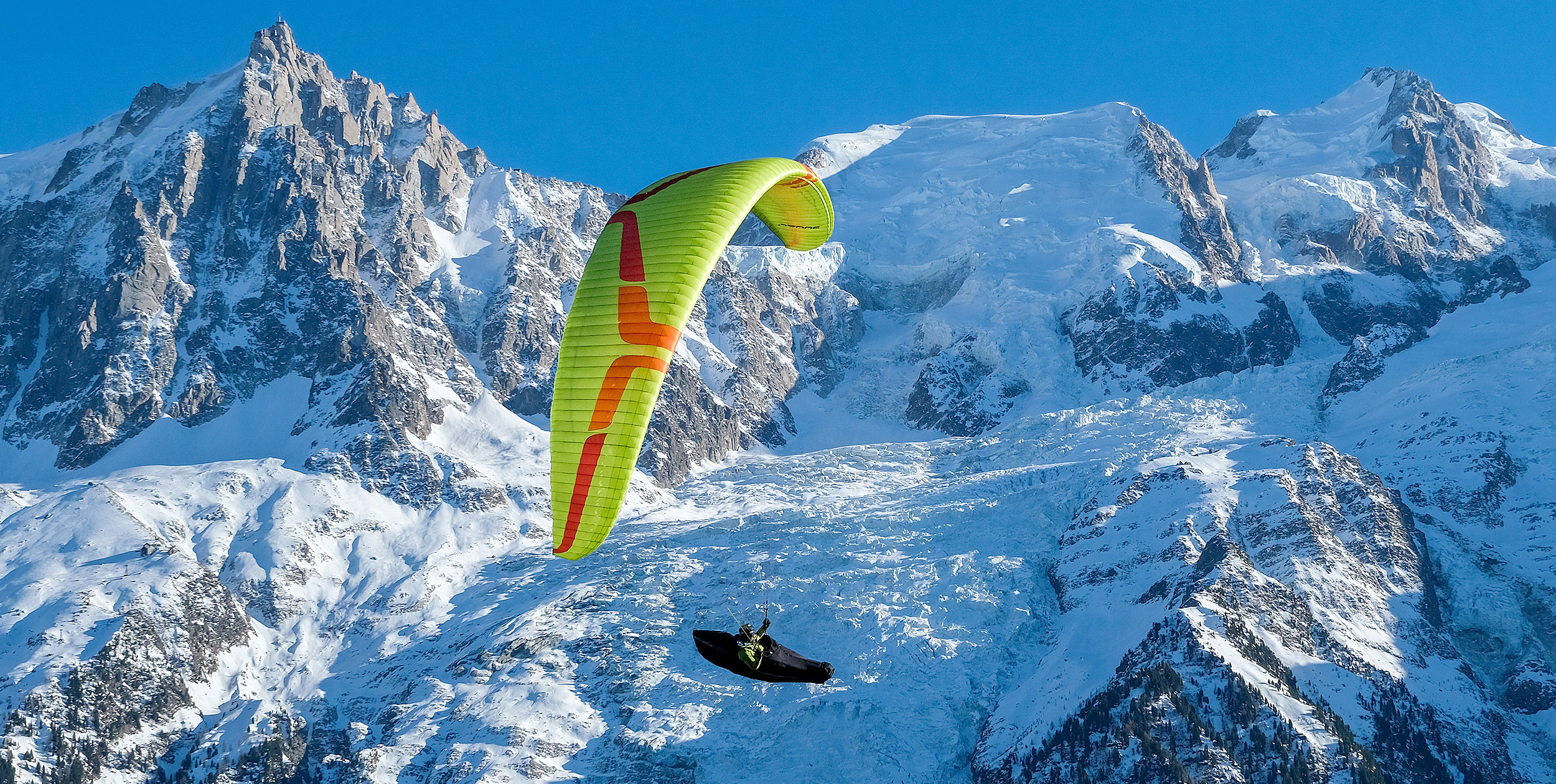
Five years ago the original Zeno was the first two-line EN D. How does the new Zeno 2 compare? Hugh Miller finds out.
We never get conditions like this in March. I’m pressing out as much speed as I dare, chest-strap tightened at 5,400ft (1,650m), gliding as hard as I can upwind under a strong street. My Oudie’s lift tone is screaming interspersed with “airspace, airspace” voice warnings. To be honest, it’s all a bit much. I wonder how I got here, flying a small triangle on the first epic day of the year, in my usual state of excitement-fear-excitement-fear.
If you could imagine the opposite of Honorin Hamard – it’s me. While Honorin is the confident, young French world number one who raced his Zeno 2 to not one but two victories in Colombia, I am a slightly socially awkward Brit whose 45-year-old heart much prefers the serenity of gentle XC to red-line racing in World Cups. I’m no factory test pilot, but come to the Zeno 2 having flown the Zeno, Zeolite, Leopard, Meru, Enzo 3 and M7 over the past five years.

On the ground
The Zeno 1 and Zeno 2 look pretty similar, sharing the same line layout scheme and aspect ratio and a similar planform. The first obvious difference is a more prominent sharknose. The cell openings are set 3-6cm further back, and they’re slightly bigger.
This more classic sharknose profile, combined with increased reflex, gives it a more Enzo 3 ‘sit up there and wait’ flavour on the ground. Refinements are subtle: new risers with neoprene handles and magnetic keepers, and a much lighter internal structure.
In terms of launch behaviour, this is a sorted wing – from nil to strong winds. On a near blown-out day, I groundhandled the wing 100m along the crest of a ridge with lots of bushes and mounds creating turbulence ahead of me. The wing responded well – staying pitch-stable overhead.
In nil to light wind, it came up perfectly in forward launch – no speedy tips, no delays, no drama. Easier than the Zeno 1.
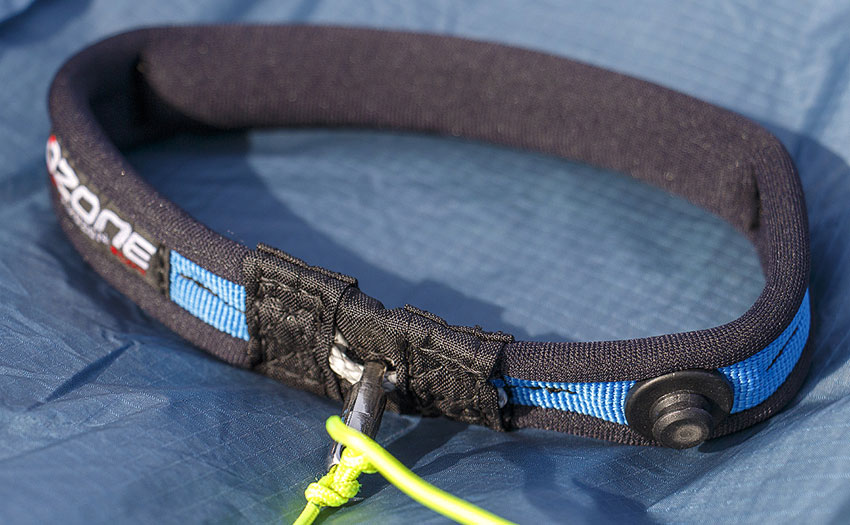
On the brakes
In the air, the wing immediately feels coordinated. The brakes are more direct – a little firmer and more responsive than the Zeno 1, and much shorter than the long-travel Enzo 3. With the Zeno 2 it feels like you get an immediate grip on the wing from the first inch of travel. That immediate connection to the trailing edge – which reminds me of the Gin Leopard – then becomes proper, workable brake range, with a nice linear build in pressure. It makes for enjoyable handling.
With the Zeno 1, I sometimes didn’t know which way to turn when entering a climb, and I’m not alone here. When I mentioned my experience of the Zeno 1 as lacking the ‘sniff’ and ‘pitch-and-lift’ feel of some other Ozone wings, one of the test team said, “you can’t have everything!” But over the years, pilots have said the Zeno 1 can feel a bit plank-like – particularly when it starts going out of trim and starts ‘hanging back’ a bit.
Not having that sniff or feel means you’re left guessing – is the core to the left or right? For me this is one of a few areas where the Leopard beats the Zeno 1. A friend with 150 hours on both the Zeno 1 and Leopard put it like this. “The Leopard makes you feel like you can catch the thermal under one wingtip, or follow a lift line like walking a balance beam, feeling which side is lifting more.”
Compared with the Zeno 1, when thermalling the Zeno 2 stays more consistently locked in pitch – with just a gentle pull forwards on the leading edge as the climb improves. This consistency – the lack of being knocked back and forth – means you can tune in to what the air is actually doing, rather than how your wing is being shunted about. This behaviour was noticed most when flying 5kg from the top of the weight range, rather than at the top.
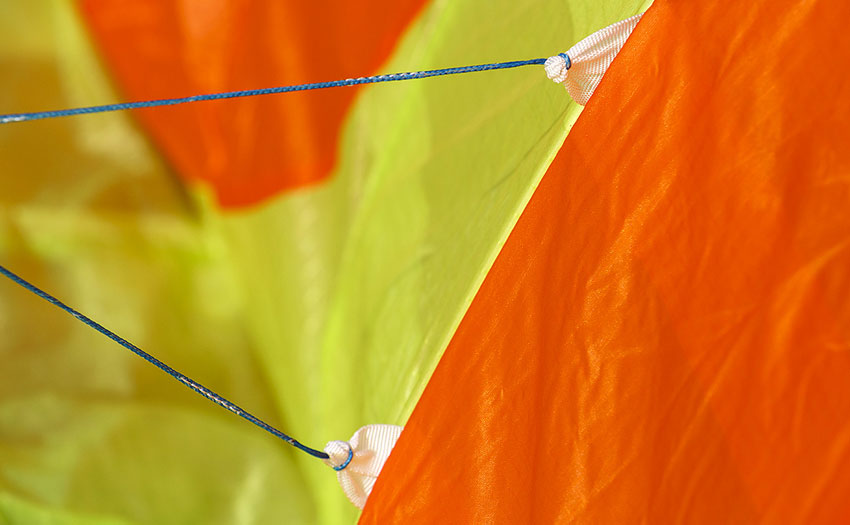
The Zeno 2 also maintains a more consistent angle of roll around the 360. I found the Zeno 1 liked to leap forward, requiring frequent outside brake management in livelier thermals to catch the dives. It also had a tendency to straighten up at inopportune moments in the strongest lift right when I wanted to stick a tip in and wang it round. This might be because the Zeno 1 was flatter across its span – the Zeno 2 has more arc.
With the Zeno 1, some pilots described having to “relearn” how to thermal: this won’t be an issue with the Zeno 2, which just stays rotating, needing very little outside brake movement. This gives a more relaxed, smooth climbing experience, but also means that when the leading edge is drawn this way or that, you can have more confidence in going with it.
It’s a smooth operator, but coming from an Enzo 3, well you’re going to have to work on your listening skills! The Enzo 3 is incredibly informative – perhaps due to its higher aspect ratio – and unbeatable in weak stuff.
All in all, when thermalling and flying on the brakes it feels like a solid, dependable friend – really not much to surprise the highly competent C or D pilot.
The glider also tolerates deep brake input, meaning you can flap and mush in when landing in a tight spot with confidence. This is a great characteristic in terms of safety, helped perhaps by the pronounced sharknose which gives better behaviour at high angles of attack. It’s certainly not vague in telling you where the stall point is – which is reached progressively.
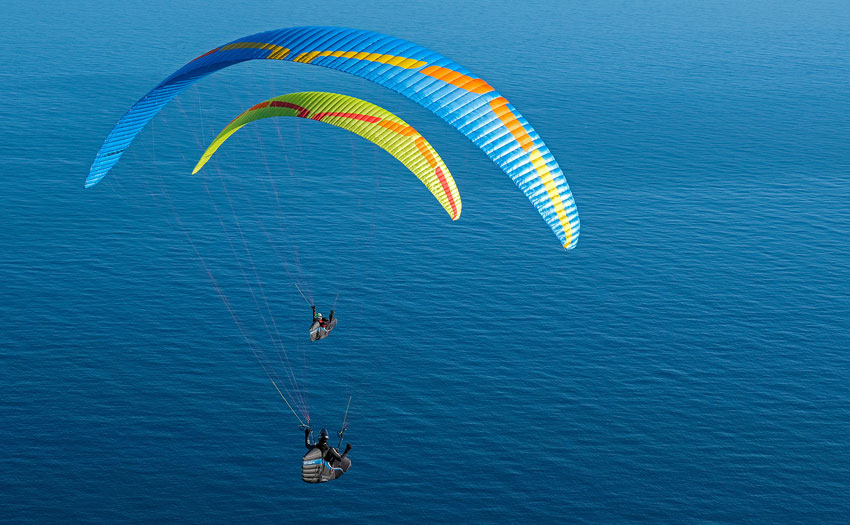
On the B’s and the bar
When Seb Ospina and I tested the original Zeno, Seb shot a video of himself thermalling just using the B’s. Pretty revolutionary at the time. The Zeno 2 is even better. You can hunt about, zigzagging into lift using the B’s, before even doing your first 360 on the B’s (if it’s not too rowdy), then switching to brakes. Obviously the wing flies faster like this, but the B’s are light enough to do this comfortably on the non-pumping days.
The B’s remain moderate in pressure as you start pushing bar. Push further, and moving onto the second step of the bar, the Zeno 2 progressively becomes a gruntier, snakier, racier wing.
I needed to tighten my chest strap to reign in some of the roll and movement of the wing. My Impress 4 just has a standard waist strap for this – it’s not quite enough. I missed the lock-in, lock-off cross-bracing mechanisms of harnesses like the Woody Valley XR7 and Kannibal Race 2 which will come into their own with this wing. The Zeno 2 wriggles a little, and looking up it’s as if the line groups react slightly individually to the chunks of turbulence they absorb through the wing.
Pushing bar through strong thermals and dolphining along long sections of lift is an excellent way to test the punch and solidity of a wing, and how it handles the turbulence it’s thrown. Overall the Zeno 2 performed well and a solid seatboard competition harness will help dampen things down.
Incidentally, one reason you can fly an Omega XAlps, Zeolite or similar lightweight two-liner with a light hammock harness is because of its lower aspect ratio. With an A/R of 7 to manage, many pilots prefer the authority and spanwise damping that a seatboard and better cross-bracing gives you to fly safely at speed. It just makes for a more comfortable ride.
And of course a good fairing will help keep you weathercocked into wind – it’s so frustrating having your pod getting shunted diagonally when flying on bar, which happened all the time when I flew the Zeno 1 with a Forza.
At higher speeds, the B’s are a little more communicative and responsive than the Leopard and definitely lighter, indicating less proportional loading on the B’s than the A’s. The glider reacts quickly to inputs. All in all it’ll be intuitive to established two-line pilots.
During testing, I had a drag race with a friend on a freshly re-lined Zeno 1. With the Zeno 1 accelerated at top speed, the Zeno 2 still had a third of travel left to go. It’s like the Zeno 2 has an extra ‘warp factor’ button built in. It’s a comfortable 4 or 5km/h faster than the Zeno 1, according to our tests.
However, the extra speed comes with a health warning: Ozone state that the final 2-3cm of travel between the pulleys are designed for World Cup pilots diving for the line, or pushing for a 10m/s climb in properly epic conditions. They’re not for general use. As speed increases, energy increases exponentially – take care!
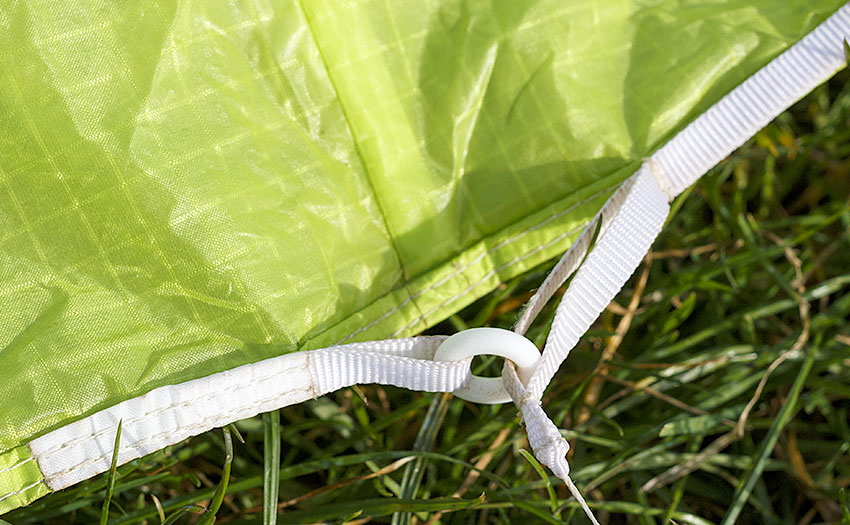
Where it fits
Some pilots are asking whether the Zeno 2 will make three-liner D’s obsolete. I don’t think so. If it were a boxing match, for my money, a wing like the Omega XAlps would stand a better chance of knocking out a three-liner D – because it’s a more accessible wing. It’s too early to say, but perhaps the real threat to the survival of three-line EN-Ds comes from the exciting emergence of the new EN-C two-liners (the Volt 4 is A/R 6.5, with one size certified at time of writing).
But for now, nothing I’ve experienced with the Zeno 2 would make the three-line D’s obsolete – there are critical differences in demand and handling, particularly at speed. And of course pilots move both ways. Some will move from a two-liner to a performance D for very good reasons – including overall comfort across a range of conditions.
Equally, while clearly highly competitive, the Zeno 2 doesn’t make CCC wings obsolete because in weak conditions, higher aspect competition wings will have the edge. If I had a CCC wing, I wouldn’t be rushing to sell it just because I’d seen the world number one win a couple of competitions with the Zeno 2 and a Submarine harness. I’d try and buy a Submarine!
Wing loading
In terms of loading, it feels great in strong air stuff at the top of the range. The wing digs in and feels at its sportiest – perfect for cranking up close to those mountain cliff faces (while hyper-ventilating, if you’re anything like me).
However, some feedback is sacrificed. At 96kg I found it much more communicative, and more ‘nose-up’ in climbs. The handling’s a fraction softer, but acceptably so. Fly it at 93-96kg, with the option to add 4-5kg of ballast, and I can’t see you being unhappy!

The verdict
The Zeno 2 is a solid, dependable two-liner. Don’t believe the rumours that it fits somewhere between the Zeno 1 and the Enzo 3 in terms of demand – it isn’t true. It has excellent handling (dare I say it, like an Advance glider), and a level of speed and performance that will allow respectful pilots to get more out of it as their abilities progress.
To me, what’s most impressive is the behaviour in climbs: planted, consistent, and reassuring – easier to fly than the Zeno on brakes, but perhaps a little more demanding on bar.
If I was to be picky, well I still miss some of the sniffiness of the Enzo 3, Zeolite, and – for those with long memories – the M6, Delta 2 and LM5 – but the Zeno 2 is definitely more communicative than the Zeno 1. It’s like having the blinkers taken off.
Can’t afford the price tag? Honestly, all the 7.0 AR EN-D two-liners I’ve flown are still brilliant wings for 2022. Two-liner glider development is now about refinements over a five-year cycle. Think about the Zeno 2 as a great upgrade rather than a completely new creation – like going from an iPhone 11 to an iPhone 13 Pro.
The Zeno 2 is nicer to fly, a little more intuitive, glides better at speed, and goes quicker – so it’s a good investment if you’re thinking of competing in the next two or three years. But meanwhile, make good decisions and take good lines on your current wing and those flash Zeno 2 pilots and their cash won’t get away from you.
In fact you’ll probably have the last laugh – until they push their bars and dive for the line, that is.
Manufacturer’s SPECIFICATIONS
Ozone say: “Designed for highly experienced XC pilots who fly at least 100 hours a year, have a solid SIV background, and who need XC record hunting / competition-level performance.”
Use: XC and competition
Pilot level: Advanced pilots
Sizes: S, MS, ML, L
Flat area (m2): 21.0, 22.5, 24.1, 26.5
Weight (kg): 4.7, 4.92, 5.22, 5.54
Take-off weight (kg): 75-90, 85-100, 95-110, 105-125
Cells: 78
Flat aspect ratio: 6.9
Certification: EN D
Hugh flew the Ozone Zeno 2 MS for 20 hours in thermic spring conditions, including a 125km XC
Published in issue 230 (June 2022)



